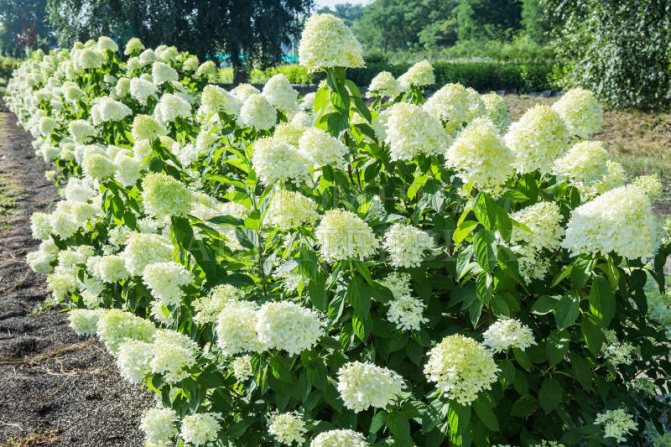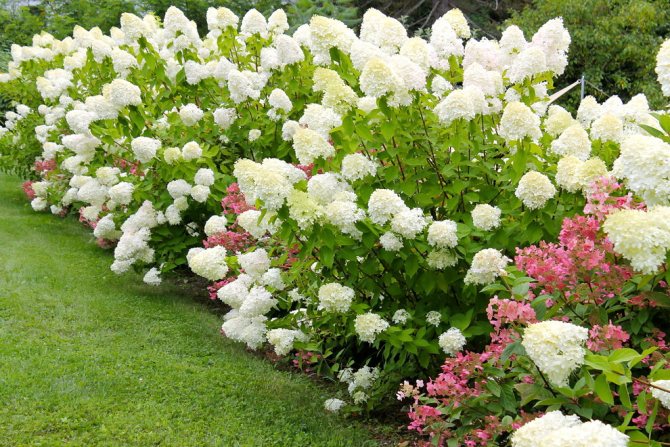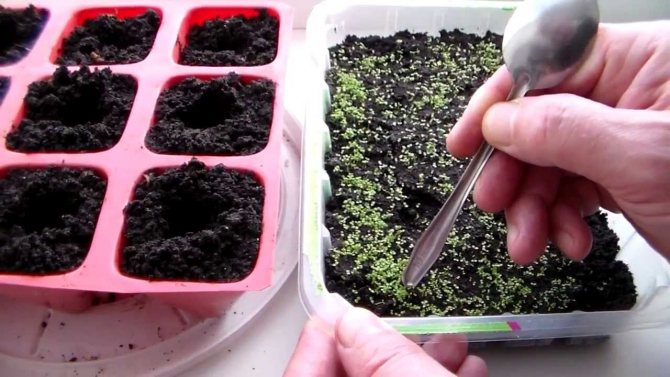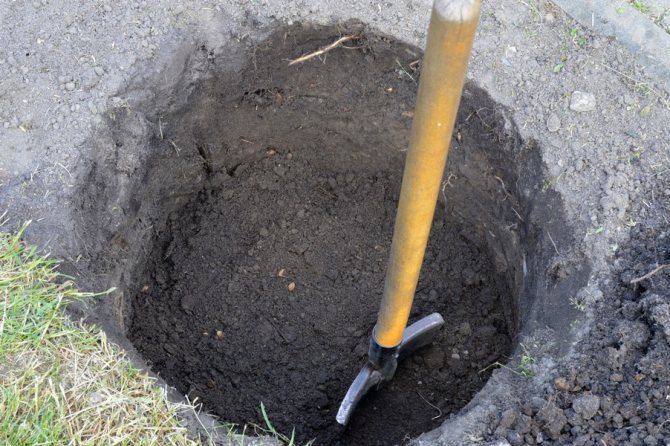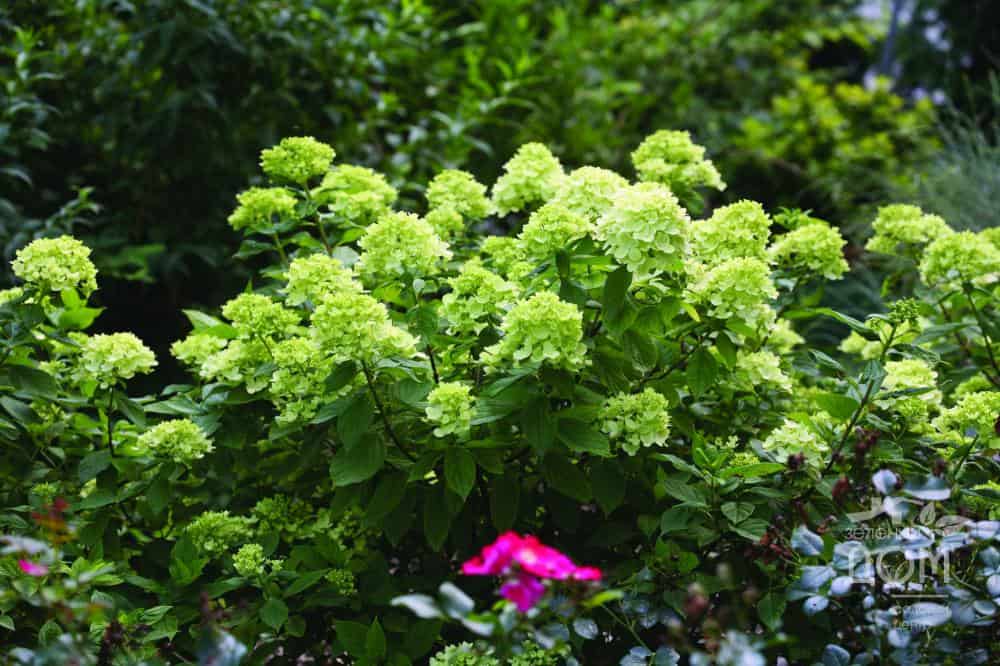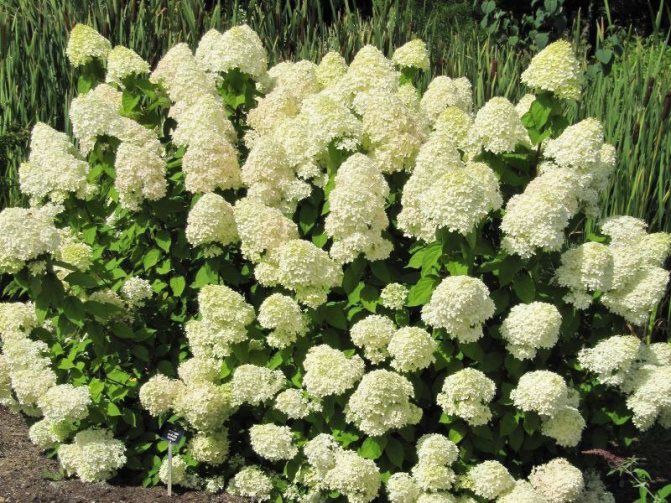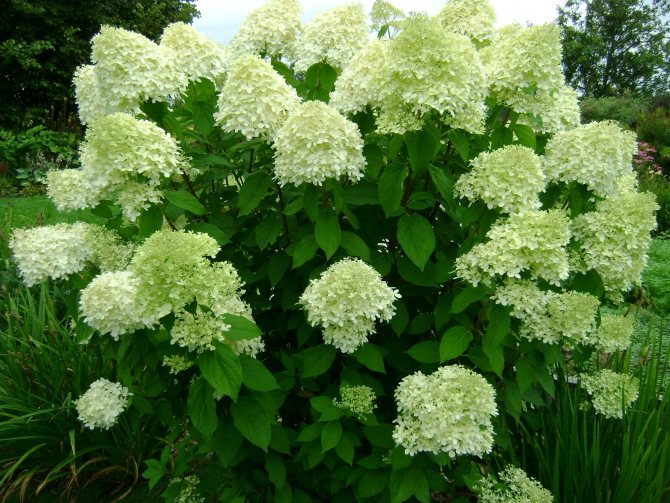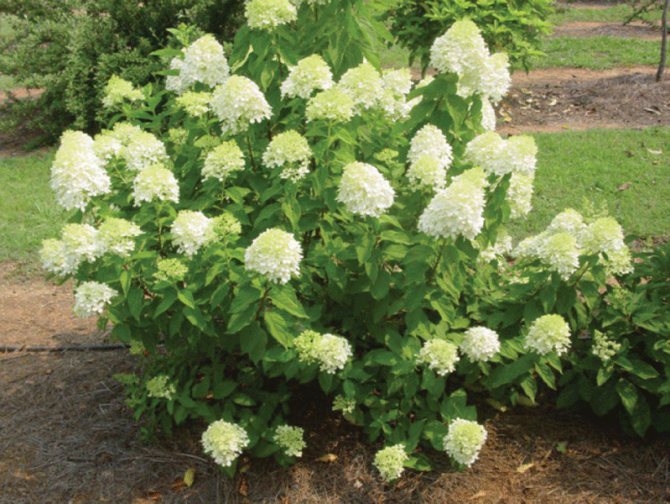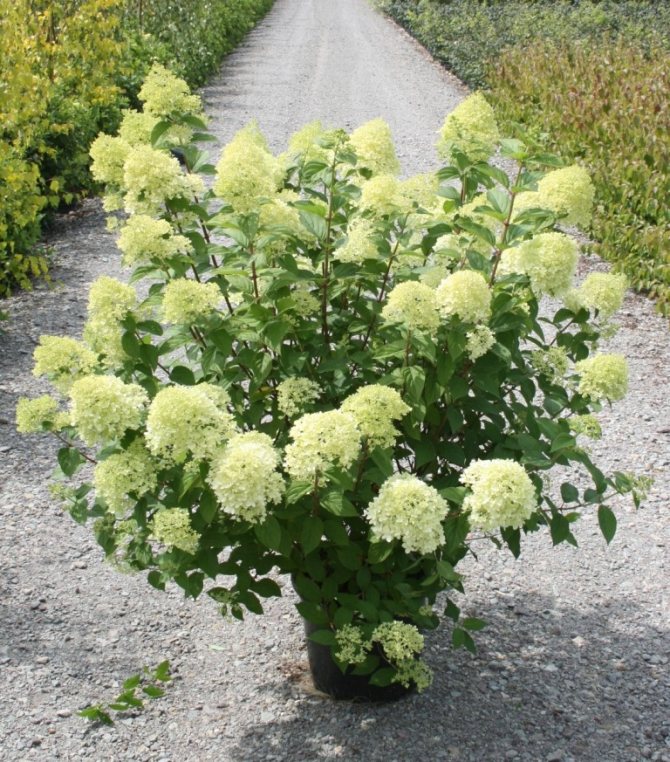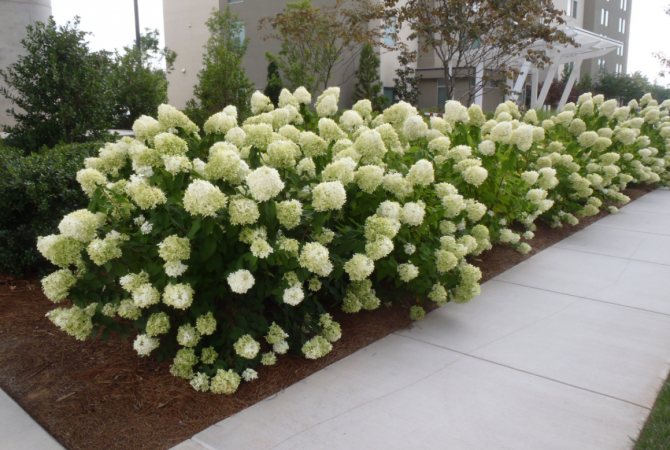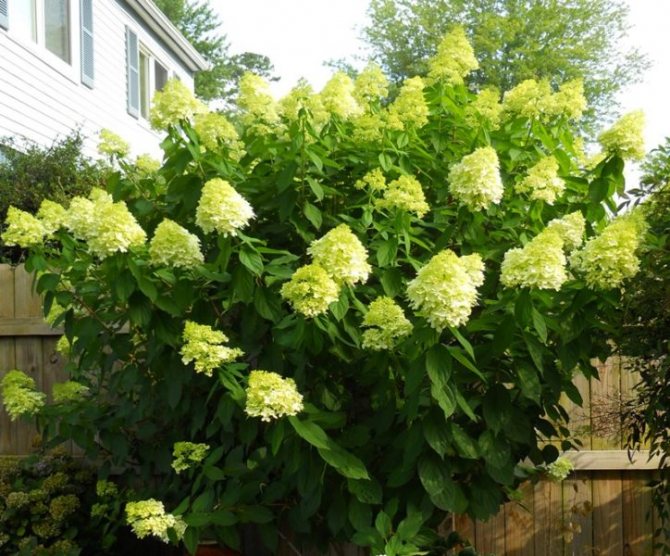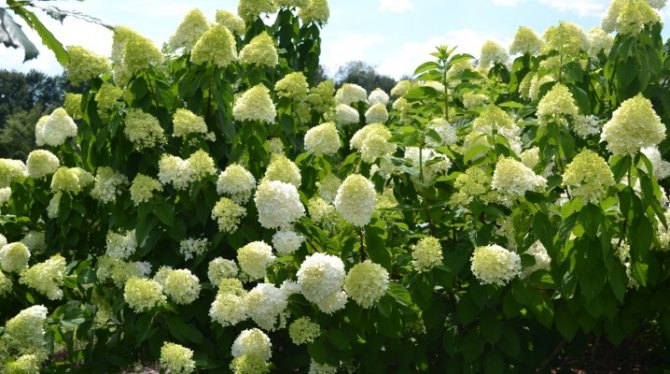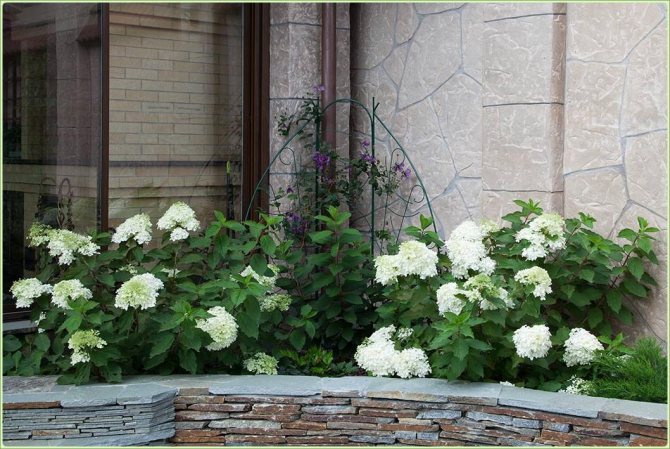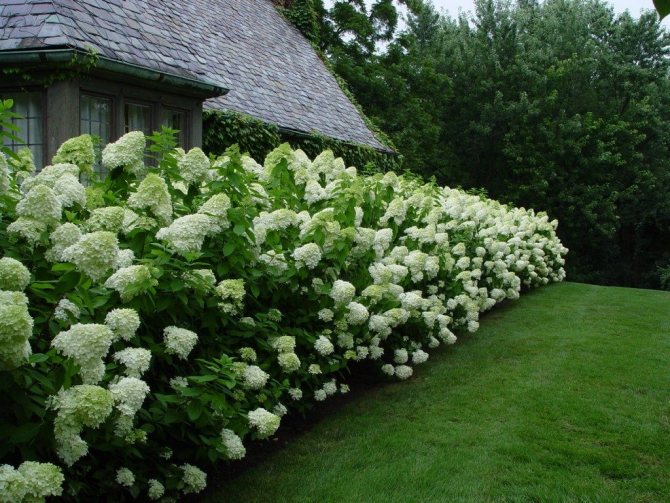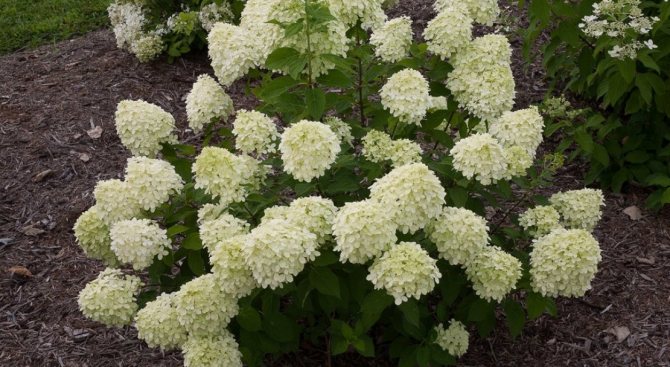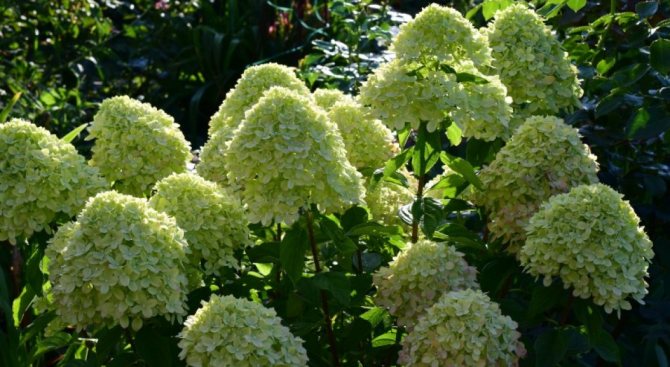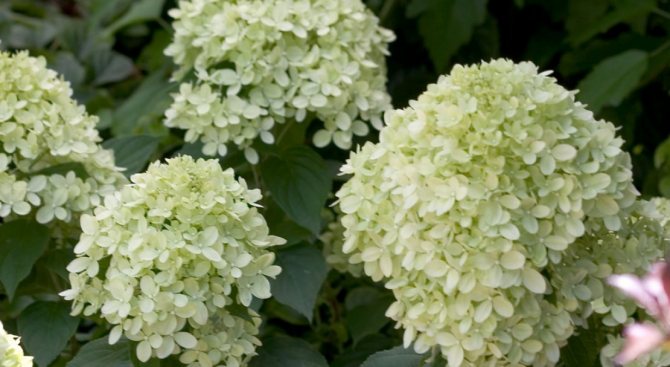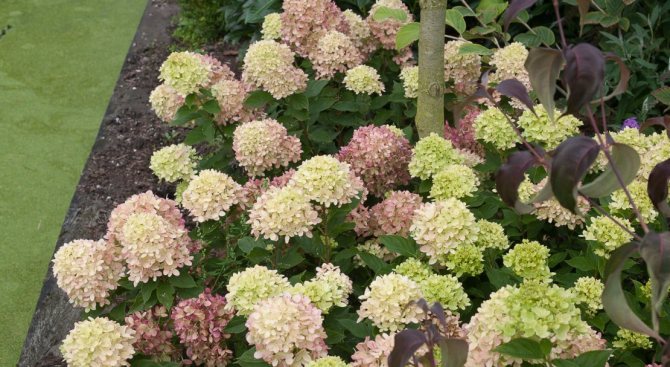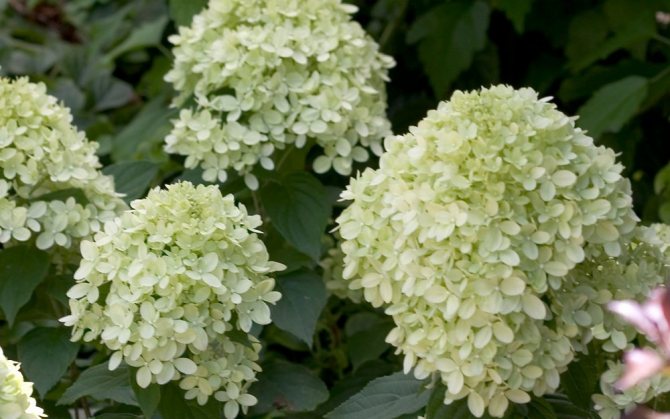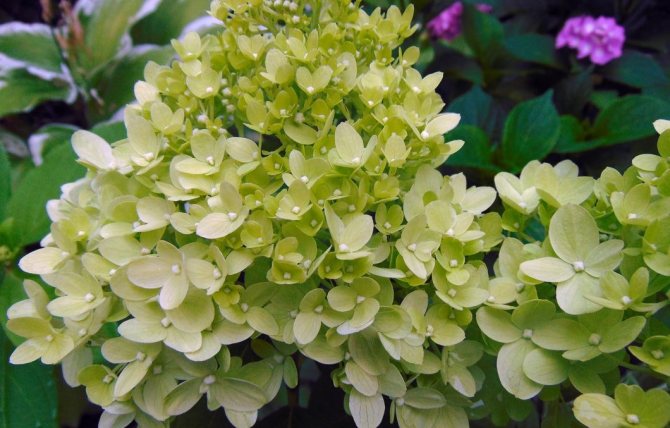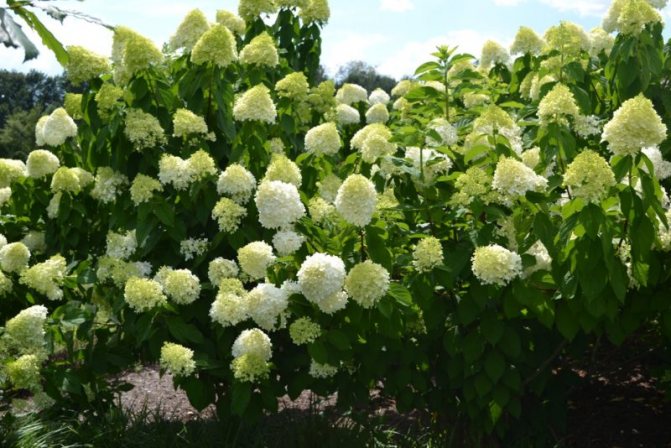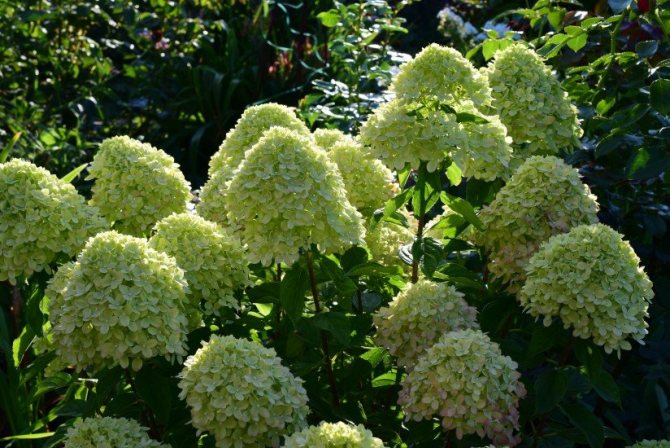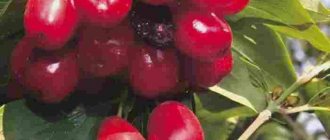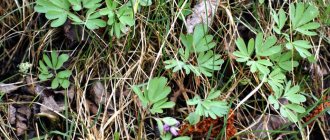A variety of panicle hydrangea "Limelight" bred by Dutch breeders. He immediately gained popularity, since it is devoid of many of the shortcomings that other varieties of this species have.
Particularly valuable is the presence of strong and tough shoots that easily support the weight of numerous large inflorescences during the flowering period. Therefore, the Limelight bush retains its original compact and highly decorative form. Also, this variety is famous for its long flowering and unusual color of flowers.
Constancy
When planting this culture, it is necessary to take into account the fact that representatives of this family are real long-livers, and a plot should be allocated for them, on which you do not plan to build buildings in the coming years. One of the reasons for this consistency is the superficial nature of the plant root system.
Fact! In adults, the roots are located close to the ground, while the root diameter may be higher compared to the diametrical value of the crown.
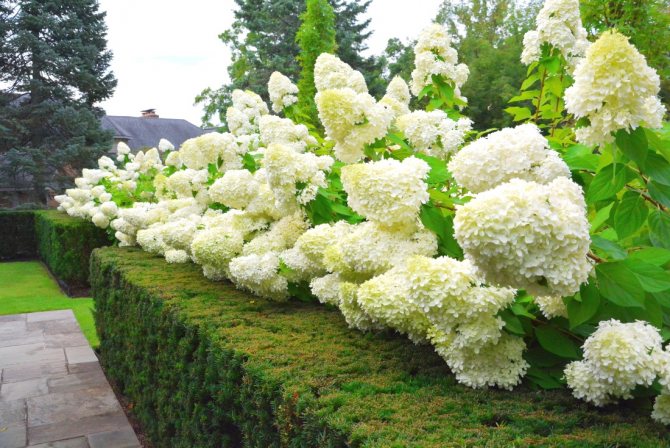
Hydrangea is good as a hedge
In the process of transplanting an adult flower, there is a huge risk of root injury, which will significantly worsen the general condition of the plant culture.
Description and photo of hydrangea paniculata Limelight
Limelight panicle hydrangea is a flowering deciduous shrub. It can reach a height of 2.5 m. It grows quite quickly, the annual growth is about 25 cm. It has a spreading crown, which, with the help of formative pruning, is easily given the desired shape.
The branches of the plant are straight and tough. The shoots are dark brown. No garter or support required during flowering.
The leaves of the plant are dark green in color and velvety texture. In the fall, the foliage of Limelight hydrangea takes on a purple hue. This makes the shrub even more decorative. The foliage of the plant is very dense, usually it completely hides the shoots.
Hydrangea "Limelight" blooms from the beginning of July to the horses of September... Sometimes, if the plant is planted in a place protected from the cold wind, flowering can be extended until mid or even until the end of October.
The flowers are small, after blooming, they are painted in bright green. Over time, they turn white, and by autumn they acquire a pink tint. Their color is directly related to illumination. In partial shade, the flowers have a juicy green color, and in a more illuminated place, they are light green or even white.
Limelight hydrangea flowers are collected in large cone-shaped inflorescences. Their length can reach 25 cm.
Watering
Hydrangea is a plant that cannot do without moisture for a long time, and this fact is reflected in the Latin name of the plant. The soil in which the culture grows must always have a sufficient degree of moisture.
1
4
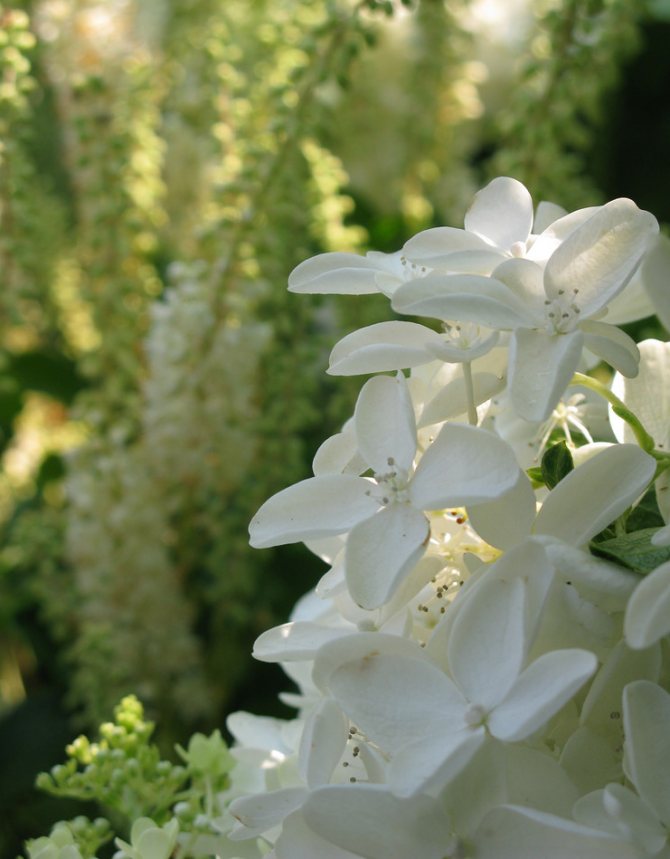

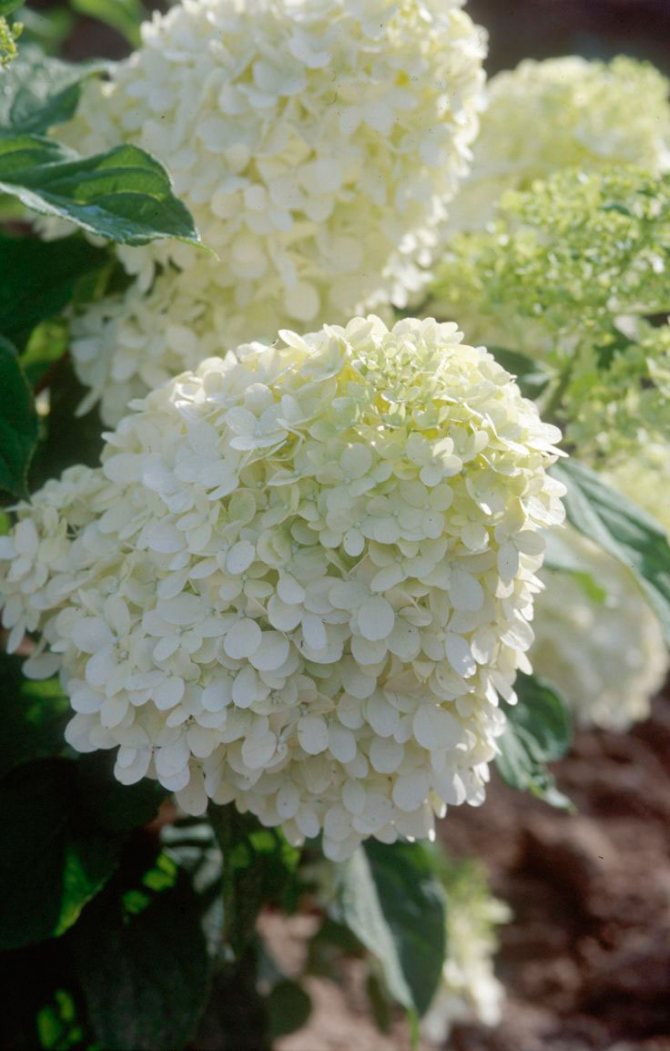



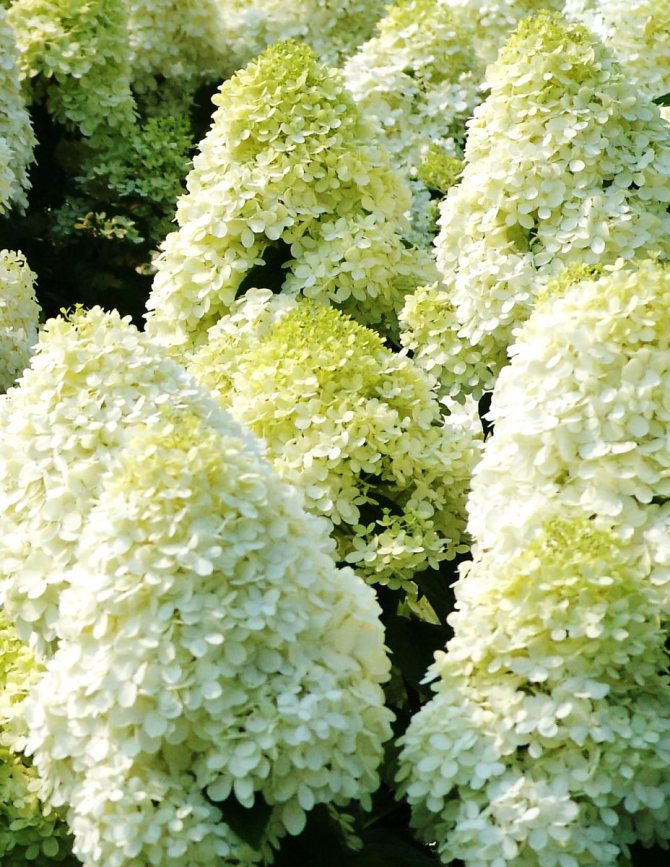

Planting Limelight hydrangeas in the garden
It is recommended to plant the plant in early May. This should not be done earlier, since warm weather can be replaced by cold and even frost. And later the heat begins, which delays the development of young bushes.
For landing in the ground, a landing hole is dug. It should not be deep, as the plant has a shallow root system. It is enough to make a hole about 40 cm deep and 60 cm in diameter.
2 buckets of water are poured into the finished pit.In a day, when the water is absorbed, you can start planting. The pit is filled by 1/3 with an earthen mixture, which includes in equal parts:
- Garden soil taken out of the pit;
- Coniferous land;
- Humus;
- Peat;
- Sand.
Also, a handful of superphosphate is added to the soil mixture for each plant.
The seedling is placed in the center along with a lump of earth. Then the pit is filled with prepared soil and slightly compacted. A properly planted bush should have a root collar at ground level.
After planting, the seedling is well watered... 1 bucket of water is poured under each plant. It is recommended to mulch the trunk circle with sawdust, peat or straw. This will save the root system from overheating in the summer and retain moisture in the soil.
Hydrangea care
Hydrangea paniculata "Limelight" is an unpretentious plant. It is not easy to look after and it does not take much time. But to get lush flowering, the plant must provide:
- Regular watering;
- Top dressing with fertilizers;
- Formative and sanitary pruning.
The shrub should be watered periodically so that the ground under the bush always remains moist. In spring and autumn, watering is carried out every 2-3 weeks. In summer, in the heat, you need to water more often - 1-2 times a week.
Hydrangea Limelight is fed for proper development and annual flowering. Without feeding, flowering can be poor, and sometimes the bush refuses to bloom at all.
Top dressing begins in May during active growth. Before the first buds appear, I fertilize with nitrogen compounds. Good results are obtained with the usual infusion of mullein. With this top dressing, the bush builds up its leaf mass and prepares for flowering.
You can read more about feeding hydrangeas here.
With the appearance of the first buds and until the end of flowering, fertilizing with potassium-phosphorus fertilizers is carried out. Particularly popular are special fertilizers for hydrangeas, which can be purchased at flower shops or garden centers.
An obligatory procedure in the care of hydrangea paniculata Limelight is its pruning.... There are the following types of trimming:
- Formative;
- Sanitary;
- Anti-aging.
Form a bush in early spring before bud break. In this case, you need to try to leave intact all the shoots of the last year, since it is on them that the buds will be laid.
The rest, if they are very long, are shortened by 2/3, others - by 1/3 or less. In this case, the bush is given the desired shape. You should also cut out the branches growing inside the crown so that it is not thick with a rumor.
Sanitary pruning is done in the fall at the end of October... All damaged, dry and diseased shoots are removed. All weak branches and old inflorescences are also cut off, shortening the shoots by 2-3 buds.
For very old bushes, rejuvenating spring pruning is carried out. All old branches are cut, leaving 4-5 youngest ones. They are shortened, leaving 4-5 buds. Sometimes they carry out radical pruning "on a stump".
Gardeners' opinion
After reviewing the photos and reviews, purchasing a Limelight hydrangea, you can be sure that it will decorate the garden with its lush flowering. The main thing is to organize proper watering and fertilizing for her.
Hydrangea of this variety has been growing on my site for 5 years. No diseases or pests were noticed. The only thing that I could not find specialized fertilizers and therefore during flowering I feed with flower fertilizer for budding.
Julia, Tula
An excellent variety of Limelight. Planted and grows for the second year without problems, the only thing that requires watering almost constantly in hot weather. But I have water nearby and therefore receives water without restrictions.
Svetlana, Zlynka
Wintering
The Limelight variety is frost-resistant and can withstand winter frosts in the middle zone. But in young specimens, the branches may freeze slightly. This is undesirable, since when the shoots that have grown in the past year freeze, the plant will not bloom.Therefore, bushes growing in the garden for less than 3 years need to be covered for the winter.
Before the shelter for the winter of young bushes of hydrangea paniculata Limelight, their sanitary pruning is carried out.
Then they are carefully hilled, after which the near-stem area is covered with a thick layer of sawdust and dry fallen leaves.
Bushes of the "Limelight" variety are quite tall, so usually their branches are bent to the ground before shelter and securely fixed... From above, the bush is covered with fallen leaves and covered with spruce branches. From above it is covered with roofing material. Small young bushes can be covered with a chain-link frame that is installed around the plant. The space between the frame and the plant is filled with dry foliage.
Adult plants do not need to be covered. The older the bush, the higher its frost resistance.
Growing conditions
Growing hydrangea "Limelight" does not require much experience from the gardener. The variety is relatively unpretentious, withstands planting both in the sun and in the shade, but needs careful care of the roots. In addition, the woody shrub does not need a garter and support of the branches, it keeps the shape of the crown well and does not break under the weight of the inflorescences, like other types of hydrangeas.
Lighting
The panicle hydrangea variety Limelight is not overly sensitive to the amount of light and can thrive in the shade. But for the full disclosure of its decorative properties, it is still recommended to use illuminated places for planting. In this case, the hydrangea will give abundant flowering and will be decorated with lush panicles throughout the warm season. But at the same time, it is important to protect the plants from drafts, strong winds, which can damage the shoots.
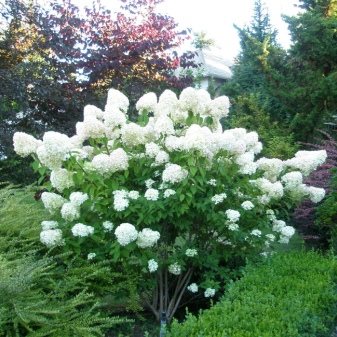

Temperature and humidity
The hydrangea variety "Limelight" is considered frost-resistant, but it does not tolerate a drop in temperature to -29 degrees and below. If the temperature is colder in winter, cultivation in a greenhouse is recommended. This shrub belongs to deciduous species, after shedding the foliage, it is recommended to take shelter. It also does not tolerate extreme heat, drought - during such periods, you need to be especially careful about the condition of the soil in the root area.
Moisture is what really matters to this hydrangea. The variety is hygrophilous and needs frequent abundant watering, but places with a high level of groundwater are contraindicated for it. This can lead to decay and death of the roots. If the hydrangea is planted in a lighted place, the earth will have to be protected from drying out.
To do this, the near-trunk circle is shaded with the help of other plantings or mulched with a thick layer of grass, peat.


The soil
Soil type is also important. Limelight grows well in soils with low or high acidity. Neutral soils are not suitable for growing it; when preparing a site, you can improve the composition by adding a significant part of the peat to it. It will increase the acidity and create conditions for the normal growth of the shrub. Alkaline soils are completely unsuitable for this plant - hydrangea quickly dies on them. The optimal soil mixture for planting this variety will consist of 2 parts of humus, the same amount of leafy soil and 1 part of peat and sand. Liming of the soil must not be allowed.


Characteristics of culture
Hydrangea grows as a shrub up to 3 m in height, a small tree or liana climbing trees. It can be deciduous and evergreen. Most garden hydrangeas are deciduous.
Flowers are of 2 types: spherical and panicle-shaped. The buds contain 2 types of flowers: fertile, growing in the middle and sterile, located at the edges. Infertile are usually larger in size. It happens that all fertile flowers are of the same size. The fruit of the hydrangea is a box with several chambers containing small seeds.
The leaves of the plant are opposite, large, oval with a slight pointed upward.Veins are clearly visible on a sheet plate with a serrated edge.
Additional Information! Depending on the types of fertilizers applied, hydrangea can change the color of the buds: phosphorus gives pink color, aluminum - blue.
Diseases
Frequent diseases of hydrangea are chlorosis. This disease causes yellowing and shedding of foliage, dryness and brittleness of the branches, as well as the gradual crushing of the inflorescences. The main symptom of downy mildew is the appearance of oily spots on the leaves, which later turn yellow and darken, gradually increasing in size. Chlorosis can cause too much lime in the soil, and downy mildew is too humid. For the prevention of chlorosis, it is imperative to carry out regular complex fertilizing of the soil.
Also, hydrangea can be affected by pests that parasitize young leaves. Spider mites, green leaf aphids, meadow bugs drink the juices of the plant and cause leaves to fall, which leads to a deterioration in the decorative qualities of the plant.
Too high humidity and tightness can cause an invasion of snails and slugs, which can greatly harm the plant.
If there are too many harmful organisms, plants are treated with drugs such as Karbofos, Fitoverm, Actellik. Meta is recommended against slugs.
As you can see, it is not very difficult to care for a plant, especially if it is already an adult. To grow successfully, she needs peace, light and moisture. Observing these simple recommendations, you will get an excellent result, its appearance will only delight you.
Hydrangeas growing on the street are not afraid of pest attacks and are not susceptible to disease. If the plant is grown in greenhouse conditions, it can get chlorosis due to lack of nutrients. To avoid this, you need to take care of feeding the plant with complex special fertilizers in advance.
Another danger to paniculate hydrangea is aphids and spider mites. The mite is a common sucking pest that can ruin the bush very badly. A sign of its appearance is the presence of a characteristic sticky cobweb-like plaque. It is recommended to use special acaricidal agents against the tick. Ordinary insecticides are ineffective against this pest.
Aphids are another widespread sucking pest. It can be black or green. With a small number, you can get rid of it by treating the bushes with a solution of laundry soap.
Young bushes growing in open ground are susceptible to the "attack" of slugs, which eat up leaves and twigs. So that they have nowhere to hide, the area should be cleared of stones in humid places and of debris. Autumn digging of soil will be a good prevention.
Hydrangea diseases are rare. The most common is called chlorosis. Develops due to a lack of iron. It consists in a violation of the formation of chlorophyll in the leaves. The leaves turn yellow, become covered with brown spots, roll up and fall off, are subject to changes and inflorescences. The plant dies.
The struggle for the plant is carried out with root dressings in the form of an iron salt and the simplest complex fertilizers (potassium nitrate solution, as an example). Spraying the leaves with special solutions is extremely effective.
The main pests of hydrangeas, as well as other plants, are May beetles, scoops, aphids, ticks. May beetles arrive in May and feed heavily on juicy leaves and flowers. Later, the larvae complete the feast. The plant withers and dries for no apparent reason. No less dangerous are scoops - omnivorous insects.
Their family consists of gray-colored butterflies with a specific pattern on the wings. They lead an evening and nocturnal lifestyle. Their caterpillars are in the soil.
The highly toxic drug "Actellik" kills insects in a few minutes, the protection lasts for several days.Toxic "Karbofos" is characterized by rapid weathering, destruction under the influence of the sun and rain. Fitoverm is a 4th generation drug that causes paralysis and death of an insect.
Gardeners compare Hydrangea Limelight with a pearl for its pickiness and beautiful fragrant inflorescences that will not fade until autumn. Proper care, timely watering, active protection from pests and diseases will give large lush inflorescences, which, even in winter, will thank unfading beauty in the form of a winter flower arrangement.
Hydrangea diseases are extremely rare. But pests in some years can annoy her very much. Spider mites and aphids are especially common on it.
Spider mite
Spider mites are a common sucking pest. A characteristic sticky cobweb-like coating serves as a sign of its appearance. In the absence of appropriate treatments, this pest can severely damage the bushes. To combat it, special acaricidal agents are used. The use of ordinary insecticides against it is ineffective.
To treat hydrangeas against spider mites, you can use Actellik or Fitoverm. Dilute them according to the attached instructions. Processing must be carried out in dry, calm weather. After 10 days, spraying is repeated.
Aphids are a widespread sucking pest. Depending on the type, it can be green or black. It is very easy to deal with it. With a small number of pests, just one treatment with a solution of laundry soap will be enough.
If the aphid population is large enough, spraying with an insecticide solution is used. For example, you can use "Alatar", "Commander" and the like.
Usually, hydrangeas growing on the street are not susceptible to disease and are not afraid of pest attacks.
However, when grown in greenhouse conditions, this shrub can get sick with chlorosis, the cause of which is a lack of nutrients.
It is necessary to take care of feeding with special complex fertilizers in advance.
The second danger of hydrangeas from greenhouses is spider mites and aphids. Special remedies based on pyrethrum and a remedy "Fitoverma" are recommended against them.
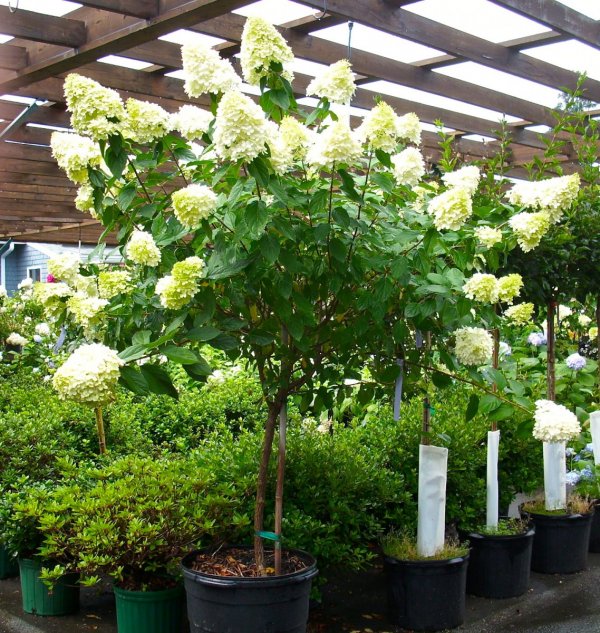

The danger for young limelight hydrangeas growing in the open field is represented by slugs, which can eat leaves and twigs and destroy the plant.
It is necessary to clear the area of debris, logs, stones in humid places so that these pests have nowhere to hide. Autumn digging can also help.
Pests and diseases of greenhouse hydrangea: chlorosis, spider mites and aphids
In order for such a unique plant as hydrangea limelight to amaze with its magnificence, you must follow the rules for caring for it.
And then, from mid-summer until late autumn, the garden will be filled with the delicate aroma of its inflorescences.
Hydrangea Limelight, belonging to the paniculate species, is an unusually beautiful plant. This variety, obtained as a result of breeding work by Dutch specialists, is rightfully considered one of the best representatives of its kind. Dutch growers have successfully solved the problem of insufficient strength of the shoots of paniculate hydrangeas, so the Limelight variety can be successfully grown without using additional support for them. Subject to all the rules and careful care, Limelight hydrangea will become a real decoration of the summer garden.
Spider mite
Pests and diseases of greenhouse hydrangea: chlorosis, spider mites and aphids
Loading ...
A variety of panicle hydrangea "Limelight" bred by Dutch breeders. He immediately gained popularity, since it is devoid of many of the shortcomings that other varieties of this species have.
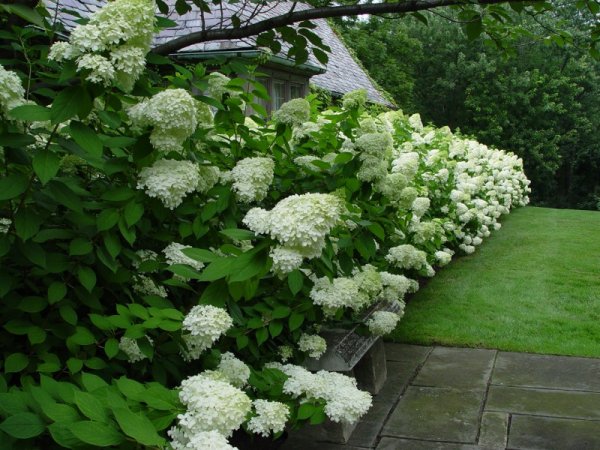

Particularly valuable is the presence of strong and tough shoots that easily support the weight of numerous large inflorescences during the flowering period.Therefore, the Limelight bush retains its original compact and highly decorative form. Also, this variety is famous for its long flowering and unusual color of flowers.
Pruning
In panicle hydrangea Lemon lime, inflorescences are formed on the shoots of the current year. In the fall, all the buds are cut out from her. In the spring, before the buds awaken, old, broken branches are cut out, and 6-12 of the strongest are left. Old shoots are cut into a ring, and strong ones are shortened by 3-4 pairs of buds. This procedure will promote more lush flowering.
If you cut out all the shoots, and leave only one, you can form a hydrangea in the form of a tree - a trunk. Its branches develop only in the upper part. They will also need to be shortened periodically. If the plant is cut correctly, the result is a small tree with a lush crown.
Reproduction
It is not difficult to propagate hydrangeas, there are several methods available, including sowing seeds obtained after seasonal flowering. However, it should be borne in mind that it is better to propagate with seeds a natural variety of shrubs, and not a selection specimen, since the seeds are not able to transfer all the genetic material of the bred variety to a new plant.
Hydrangea paniculata Grandiflora (Grandiflora) - description
This is the method and the longest - after the emergence of seedlings, sprouts can only be dived into open ground after they reach the age of three.
The easiest way to get new Lime Light hydrangea is by dividing the bush. This option is relevant when an adult plant needs a transplant or thinning of densely overgrown areas.
Most often, flower growers resort to the grafting method. This requires cutting off the young side shoots from the plant. For rooting, it is necessary to remove the tip at the appendix, shortening it so that only 3-4 leaves remain on the trunk. It is recommended to put the prepared stalk not just in clean water, but in a solution with stimulants for the development of the root system.
Important! The leaves of the shoots should not touch the water (solution).


